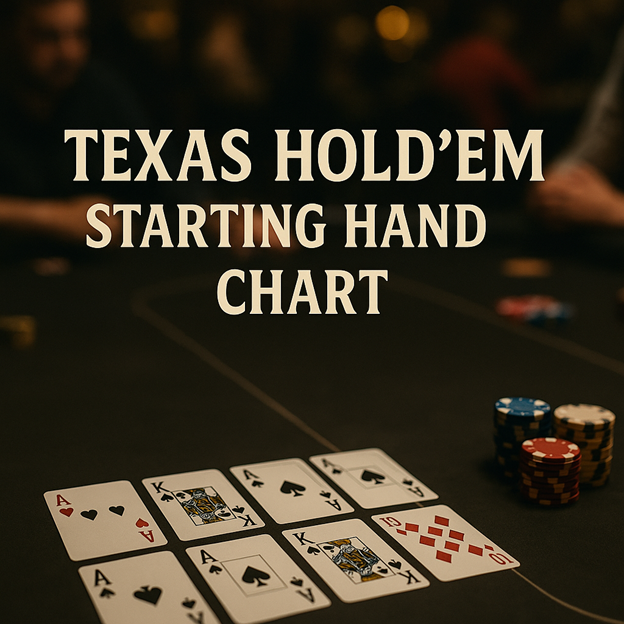Learn which poker hands to play, when to fold, and how to build a winning preflop strategy.

Introduction Why Starting Hands Matter
In poker, the biggest difference between winning and losing players comes down to one thing: which hands you choose to play and which ones you fold.
No-Limit Hold’em is a game of skill and discipline. Your decisions before the flop the preflop often decide how the whole hand will end.
If you start with the wrong hands, you’ll often end up in tough situations after the flop. That’s why good starting hand selection is the foundation of long-term poker profit.
Understanding Hand Strength Basics
What Makes a Hand Strong
A strong starting hand usually has one or more of these qualities:
- High cards like A, K, or Q (good top-pair potential)
- Suited cards (same suit, which can make a flush)
- Connected cards (next to each other in rank, which can make a straight)
Hand Categories (Simple Table)
| Category | Example Hands | Strategy |
| Premium | AA, KK, QQ, AKs | Always raise or re-raise |
| Strong | JJ–99, AQs, AJs, KQs | Open-raise from most positions |
| Playable | 88–55, T9s, 98s | Call in late or multiway pots |
| Marginal | A9o, KJo, QTo | Play only in position |
| Trash | J4o, 72o, 93o | Always fold |
Texas Hold’em Starting Hand Chart (By Position)
Early Position (UTG, UTG+1)
- Play tight and strong.
- Stick to AA–JJ, AK, AQ.
- Fold small pairs and speculative suited connectors.
Why? Because you act first and other players can take advantage of your position.
Middle Position (MP1, MP2)
- Add hands like TT–88, AJ, KQ.
- You can also play suited connectors like 98s, 76s sometimes.
- Play a little looser, but don’t overplay weak hands.
Late Position (CO, Button)
- This is the most profitable spot at the table.
- Play wide: suited connectors, small pairs, suited kings, and one-gappers like 97s or T8s.
- Raise more often to steal blinds.
Blinds (SB & BB)
- Defend selectively.
- Call with medium pairs or suited connectors.
- Avoid weak offsuit hands like K7o or Q8o.
Pro Tip:
Position = Power. The later you act, the more you see what others do, which helps you make smarter choices and win more.

Adjusting to Table Type & Opponent Style
Loose-Passive Tables (many limpers)
- Limp behind with small pairs or suited connectors.
- Bet for value when you have strong hands.
- Avoid bluffing too much — these players love to call.
Tight-Aggressive Tables
- Bluff occasionally, especially from late position.
- Focus on blind steals and re-steals.
- Mix your range so opponents can’t read you easily.
How to React to Raises (Preflop Decision Matrix)
| Situation | Strong Hands | Medium Hands | Speculative Hands |
| Facing a Raise (3–5× BB) | Re-raise with AA–QQ, AK | Fold most | Call suited connectors only with deep stacks |
| Facing Multiple Limpers | Raise big with premiums | Limp behind with pairs or connectors | Avoid offsuit broadways |
| In Blinds vs Late Raise | Re-raise premiums | Call AQs, KQs | Fold weak hands |
Tournament Adjustments
- Deep Stack (100BB+): Play the same ranges as cash games.
- Mid Stack (40–60BB): Avoid speculative calls; focus on strong broadway hands.
- Short Stack (20BB or less): Use push/fold strategy. Fewer hands, more aggression.
- Bubble or ITM Stages: Tighten up and protect your stack. Survival matters.
GTO vs Exploitative Starting Hands
GTO (Game Theory Optimal) means playing a balanced range with no obvious weaknesses.
But in low-stakes live games, an exploitative approach often wins more because opponents make big mistakes.
Example: Limping small pairs like 22–55 can be fine if several players have already limped in.
In theory, GTO says fold, but in real games, you can make money from opponents who play too many hands.

Common Preflop Mistakes to Avoid
- Playing too many offsuit hands like KJo or QTo
- Calling raises out of position
- Ignoring your stack size or table type
- Overvaluing “pretty” hands like KQ or AJ
- Folding too often from the Button or Cutoff
Max vs Full-Ring Differences
| Format | Range Width | Play Style |
| Full Ring (9–10 players) | Tight | Patience is key |
| 6-Max (Online) | Looser | More aggression |
| Heads-Up | Very wide | Any Ace or King is playable |
Quick Reference Cheat Sheet
Color Key:
- Green: Always Raise
- Yellow: Raise or Call depending on position
- Red: Fold
Download:
Get your free Texas Hold’em Starting Hand Chart PDF — perfect for quick study or mobile reference.
FAQs
Q1: What are the best starting hands in Texas Hold’em?
AA, KK, QQ, AKs, and AQs. Always raise or re-raise with these.
Q2: Which hands should beginners avoid?
Offsuit low cards and weak kickers such as K8o, Q9o, or J7o.
Q3: Is this chart for tournaments or cash games?
It’s mainly for cash games, but you can adjust it for tournaments based on your stack size.
Q4: How can I memorize all these hands?
Group them by category — Premium, Strong, Playable, Marginal, Trash — instead of trying to remember each one.
Q5: Can I use this chart for online 6-max games?
Yes, just loosen your ranges slightly in every position.





